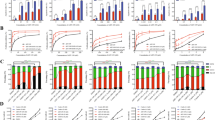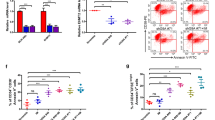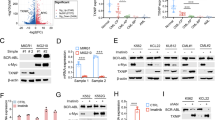Abstract
BCR-ABL transforms bone marrow progenitor cells and promotes genome instability, leading to development of chronic myelogenous leukemia (CML). The tyrosine kinase inhibitor imatinib effectively treats CML, but acquired resistance can develop because of BCR-ABL mutations. Mechanisms for acquisition of BCR-ABL mutations are not fully understood. Using a novel culture model of CML acquired resistance, we show that inhibition of SIRT1 deacetylase by small molecule inhibitors or gene knockdown blocks acquisition of BCR-ABL mutations and relapse of CML cells on tyrosine kinase inhibitors. SIRT1 knockdown also suppresses de novo genetic mutations of hypoxanthine phosphoribosyl transferase gene in CML and non-CML cells upon treatment with DNA damaging agent camptothecin. Although SIRT1 can enhance cellular DNA damage response, it alters functions of DNA repair machineries in CML cells and stimulates activity of error-prone DNA damage repair, in association with acquisition of genetic mutations. These results reveal a previously unrecognized role of SIRT1 for promoting mutation acquisition in cancer, and have implication for targeting SIRT1 to overcome CML drug resistance.
This is a preview of subscription content, access via your institution
Access options
Subscribe to this journal
Receive 50 print issues and online access
$259.00 per year
only $5.18 per issue
Buy this article
- Purchase on Springer Link
- Instant access to full article PDF
Prices may be subject to local taxes which are calculated during checkout






Similar content being viewed by others
References
Melo JV, Barnes DJ . Chronic myeloid leukaemia as a model of disease evolution in human cancer. Nat Rev Cancer 2007; 7: 441–453.
Druker BJ, Guilhot F, O’Brien SG, Gathmann I, Kantarjian H, Gattermann N et al. Five-year follow-up of patients receiving imatinib for chronic myeloid leukemia. N Engl J Med 2006; 355: 2408–2417.
Deininger MW, Druker BJ . Specific targeted therapy of chronic myelogenous leukemia with imatinib. Pharmacol Rev 2003; 55: 401–423.
Gorre ME, Mohammed M, Ellwood K, Hsu N, Paquette R, Rao PN et al. Clinical resistance to STI-571 cancer therapy caused by BCR-ABL gene mutation or amplification. Science 2001; 293: 876–880.
Shah NP, Nicoll JM, Nagar B, Gorre ME, Paquette RL, Kuriyan J et al. Multiple BCR-ABL kinase domain mutations confer polyclonal resistance to the tyrosine kinase inhibitor imatinib (STI571) in chronic phase and blast crisis chronic myeloid leukemia. Cancer Cell 2002; 2: 117–125.
Weisberg E, Manley PW, Breitenstein W, Bruggen J, Cowan-Jacob SW, Ray A et al. Characterization of AMN107, a selective inhibitor of native and mutant Bcr-Abl. Cancer Cell 2005; 7: 129–141.
von Bubnoff N, Manley PW, Mestan J, Sanger J, Peschel C, Duyster J . Bcr-Abl resistance screening predicts a limited spectrum of point mutations to be associated with clinical resistance to the Abl kinase inhibitor nilotinib (AMN107). Blood 2006; 108: 1328–1333.
Shah NP, Tran C, Lee FY, Chen P, Norris D, Sawyers CL . Overriding imatinib resistance with a novel ABL kinase inhibitor. Science 2004; 305: 399–401.
Kantarjian H, Giles F, Wunderle L, Bhalla K, O’Brien S, Wassmann B et al. Nilotinib in imatinib-resistant CML and Philadelphia chromosome-positive ALL. N Engl J Med 2006; 354: 2542–2551.
Talpaz M, Shah NP, Kantarjian H, Donato N, Nicoll J, Paquette R et al. Dasatinib in imatinib-resistant Philadelphia chromosome-positive leukemias. N Engl J Med 2006; 354: 2531–2541.
Michor F, Hughes TP, Iwasa Y, Branford S, Shah NP, Sawyers CL et al. Dynamics of chronic myeloid leukaemia. Nature 2005; 435: 1267–1270.
Yuan H, Wang Z, Gao C, Chen W, Huang Q, Yee JK et al. BCR-ABL gene expression is required for its mutations in a novel KCL-22 cell culture model for acquired resistance of chronic myelogenous leukemia. J Biol Chem 2010; 285: 5085–5096.
Guarente L . Sirtuins in aging and disease. Cold Spring Harb Symp Quant Biol 2007; 72: 483–488.
Imai S, Armstrong CM, Kaeberlein M, Guarente L . Transcriptional silencing and longevity protein Sir2 is an NAD-dependent histone deacetylase. Nature 2000; 403: 795–800.
Vaquero A, Scher M, Erdjument-Bromage H, Tempst P, Serrano L, Reinberg D . SIRT1 regulates the histone methyl-transferase SUV39H1 during heterochromatin formation. Nature 2007; 450: 440–444.
Bosch-Presegue L, Raurell-Vila H, Marazuela-Duque A, Kane-Goldsmith N, Valle A, Oliver J et al. Stabilization of Suv39H1 by SirT1 is part of oxidative stress response and ensures genome protection. Mol Cell 2011; 42: 210–223.
O’Hagan HM, Mohammad HP, Baylin SB . Double strand breaks can initiate gene silencing and SIRT1-dependent onset of DNA methylation in an exogenous promoter CpG island. PLoS Genet 2008; 4: e1000155.
Oberdoerffer P, Michan S, McVay M, Mostoslavsky R, Vann J, Park SK et al. SIRT1 redistribution on chromatin promotes genomic stability but alters gene expression during aging. Cell 2008; 135: 907–918.
Yuan Z, Zhang X, Sengupta N, Lane WS, Seto E . SIRT1 regulates the function of the Nijmegen breakage syndrome protein. Mol Cell 2007; 27: 149–162.
Li K, Casta A, Wang R, Lozada E, Fan W, Kane S et al. Regulation of WRN protein cellular localization and enzymatic activities by SIRT1-mediated deacetylation. J Biol Chem 2008; 283: 7590–7598.
Ming M, Shea CR, Guo X, Li X, Soltani K, Han W et al. Regulation of global genome nucleotide excision repair by SIRT1 through xeroderma pigmentosum C. Proc Natl Acad Sci USA 2010; 107: 22623–22628.
Wang RH, Sengupta K, Li C, Kim HS, Cao L, Xiao C et al. Impaired DNA damage response, genome instability, and tumorigenesis in SIRT1 mutant mice. Cancer Cell 2008; 14: 312–323.
Luo J, Nikolaev AY, Imai S, Chen D, Su F, Shiloh A et al. Negative control of p53 by Sir2alpha promotes cell survival under stress. Cell 2001; 107: 137–148.
Vaziri H, Dessain SK, Ng Eaton E, Imai SI, Frye RA, Pandita TK et al. hSIR2(SIRT1) functions as an NAD-dependent p53 deacetylase. Cell 2001; 107: 149–159.
Cohen HY, Miller C, Bitterman KJ, Wall NR, Hekking B, Kessler B et al. Calorie restriction promotes mammalian cell survival by inducing the SIRT1 deacetylase. Science 2004; 305: 390–392.
Motta MC, Divecha N, Lemieux M, Kamel C, Chen D, Gu W et al. Mammalian SIRT1 represses forkhead transcription factors. Cell 2004; 116: 551–563.
Brunet A, Sweeney LB, Sturgill JF, Chua KF, Greer PL, Lin Y et al. Stress-dependent regulation of FOXO transcription factors by the SIRT1 deacetylase. Science 2004; 303: 2011–2015.
Daitoku H, Hatta M, Matsuzaki H, Aratani S, Ohshima T, Miyagishi M et al. Silent information regulator 2 potentiates Foxo1-mediated transcription through its deacetylase activity. Proc Natl Acad Sci USA 2004; 101: 10042–10047.
Chen WY, Wang DH, Yen RC, Luo J, Gu W, Baylin SB . Tumor suppressor HIC1 directly regulates SIRT1 to modulate p53-dependent DNA-damage responses. Cell 2005; 123: 437–448.
Issa JP, Zehnbauer BA, Kaufmann SH, Biel MA, Baylin SB . HIC1 hypermethylation is a late event in hematopoietic neoplasms. Cancer Res 1997; 57: 1678–1681.
Yuan H, Wang Z, Li L, Zhang H, Modi H, Horne D et al. Activation of stress response gene SIRT1 by BCR-ABL promotes leukemogenesis. Blood 2012; 119: 1904–1914.
Quintas-Cardama A, Santos FP, Garcia-Manero G . Histone deacetylase inhibitors for the treatment of myelodysplastic syndrome and acute myeloid leukemia. Leukemia 2011; 25: 226–235.
Yu C, Rahmani M, Almenara J, Subler M, Krystal G, Conrad D et al. Histone deacetylase inhibitors promote STI571-mediated apoptosis in STI571-sensitive and -resistant Bcr/Abl+ human myeloid leukemia cells. Cancer Res 2003; 63: 2118–2126.
Fiskus W, Pranpat M, Balasis M, Bali P, Estrella V, Kumaraswamy S et al. Cotreatment with vorinostat (suberoylanilide hydroxamic acid) enhances activity of dasatinib (BMS-354825) against imatinib mesylate-sensitive or imatinib mesylate-resistant chronic myelogenous leukemia cells. Clin Cancer Res 2006; 12: 5869–5878.
Zhang B, Strauss AC, Chu S, Li M, Ho Y, Shiang KD et al. Effective targeting of quiescent chronic myelogenous leukemia stem cells by histone deacetylase inhibitors in combination with imatinib mesylate. Cancer Cell 2010; 17: 427–442.
Pommier Y . Topoisomerase I inhibitors: camptothecins and beyond. Nat Rev Cancer 2006; 6: 789–802.
Wang B, Hasan MK, Alvarado E, Yuan H, Wu H, Chen WY . NAMPT overexpression in prostate cancer and its contribution to tumor cell survival and stress response. Oncogene 2011; 30: 907–921.
Jung-Hynes B, Nihal M, Zhong W, Ahmad N . Role of sirtuin histone deacetylase SIRT1 in prostate cancer. A target for prostate cancer management via its inhibition? J Biol Chem. 2009; 284: 3823–3832.
Gaymes TJ, Padua RA, Pla M, Orr S, Omidvar N, Chomienne C et al. Histone deacetylase inhibitors (HDI) cause DNA damage in leukemia cells: a mechanism for leukemia-specific HDI-dependent apoptosis? Mol Cancer Res 2006; 4: 563–573.
Slupianek A, Schmutte C, Tombline G, Nieborowska-Skorska M, Hoser G, Nowicki MO et al. BCR/ABL regulates mammalian RecA homologs, resulting in drug resistance. Mol Cell 2001; 8: 795–806.
Nowicki MO, Falinski R, Koptyra M, Slupianek A, Stoklosa T, Gloc E et al. BCR/ABL oncogenic kinase promotes unfaithful repair of the reactive oxygen species-dependent DNA double-strand breaks. Blood 2004; 104: 3746–3753.
Khanna KK, Jackson SP . DNA double-strand breaks: signaling, repair and the cancer connection. Nat Genet 2001; 27: 247–254.
Cohen HY, Lavu S, Bitterman KJ, Hekking B, Imahiyerobo TA, Miller C et al. Acetylation of the C terminus of Ku70 by CBP and PCAF controls Bax-mediated apoptosis. Mol Cell 2004; 13: 627–638.
Bennardo N, Cheng A, Huang N, Stark JM . Alternative-NHEJ is a mechanistically distinct pathway of mammalian chromosome break repair. PLoS Genet 2008; 4: e1000110.
Weinstock DM, Nakanishi K, Helgadottir HR, Jasin M . Assaying double-strand break repair pathway choice in mammalian cells using a targeted endonuclease or the RAG recombinase. Methods Enzymol 2006; 409: 524–540.
Rass E, Grabarz A, Plo I, Gautier J, Bertrand P, Lopez BS . Role of Mre11 in chromosomal nonhomologous end joining in mammalian cells. Nat Struct Mol Biol 2009; 16: 819–824.
Dinkelmann M, Spehalski E, Stoneham T, Buis J, Wu Y, Sekiguchi JM et al. Multiple functions of MRN in end-joining pathways during isotype class switching. Nat Struct Mol Biol 2009; 16: 808–813.
Xie A, Kwok A, Scully R . Role of mammalian Mre11 in classical and alternative nonhomologous end joining. Nat Struct Mol Biol 2009; 16: 814–818.
Perrotti D, Jamieson C, Goldman J, Skorski T . Chronic myeloid leukemia: mechanisms of blastic transformation. J Clin Invest 2010; 120: 2254–2264.
Seluanov A, Mittelman D, Pereira-Smith OM, Wilson JH, Gorbunova V . DNA end joining becomes less efficient and more error-prone during cellular senescence. Proc Natl Acad Sci USA 2004; 101: 7624–7629.
Slupianek A, Nowicki MO, Koptyra M, Skorski T . BCR/ABL modifies the kinetics and fidelity of DNA double-strand breaks repair in hematopoietic cells. DNA Repair (Amst) 2006; 5: 243–250.
Chen WY, Yuan H, Wang Z . De novo acquisition of BCR-ABL mutations for CML acquired resistance. In: Koschmieder S, Krug U (eds). Myeloid Leukemia: Basic Mechanisms of Leukemogenesis. INTECH, Rijeka, Croatia, 2011. pp 69–84.
Brady N, Gaymes TJ, Cheung M, Mufti GJ, Rassool FV . Increased error-prone NHEJ activity in myeloid leukemias is associated with DNA damage at sites that recruit key nonhomologous end-joining proteins. Cancer Res 2003; 63: 1798–1805.
Gaymes TJ, Mufti GJ, Rassool FV . Myeloid leukemias have increased activity of the nonhomologous end-joining pathway and concomitant DNA misrepair that is dependent on the Ku70/86 heterodimer. Cancer Res 2002; 62: 2791–2797.
Kharbanda S, Pandey P, Jin S, Inoue S, Bharti A, Yuan ZM et al. Functional interaction between DNA-PK and c-Abl in response to DNA damage. Nature 1997; 386: 732–735.
Jin S, Kharbanda S, Mayer B, Kufe D, Weaver DT . Binding of Ku and c-Abl at the kinase homology region of DNA-dependent protein kinase catalytic subunit. J Biol Chem 1997; 272: 24763–24766.
Richardson C, Jasin M . Coupled homologous and nonhomologous repair of a double-strand break preserves genomic integrity in mammalian cells. Mol Cell Biol 2000; 20: 9068–9075.
Baselga J . Targeting tyrosine kinases in cancer: the second wave. Science 2006; 312: 1175–1178.
Acknowledgements
This study was supported by the following Grants: W81XWH-06-1-0268 from the US Department of Defense, a career development award from the STOPCANCER Foundation, a translational research grant from the V-Foundation and R01 CA143421 from the National Cancer Institute, NIH to WYC. RB was supported by R01 CA95684, and JMS was supported by R01 CA120954. The core facilities used in this study were supported by NCI P30 CA033572.
Author information
Authors and Affiliations
Corresponding author
Ethics declarations
Competing interests
The authors declare no conflict of interest.
Additional information
Disclaimer
The contents are solely the responsibility of the authors and do not represent the official views of the National Cancer Institute or NIH. Parts of this manuscript were used for a patent application filed by City of Hope.
Supplementary Information accompanies the paper on the Oncogene website
Supplementary information
Rights and permissions
About this article
Cite this article
Wang, Z., Yuan, H., Roth, M. et al. SIRT1 deacetylase promotes acquisition of genetic mutations for drug resistance in CML cells. Oncogene 32, 589–598 (2013). https://doi.org/10.1038/onc.2012.83
Received:
Revised:
Accepted:
Published:
Issue Date:
DOI: https://doi.org/10.1038/onc.2012.83
Keywords
This article is cited by
-
Epigenetic regulation in hematopoiesis and its implications in the targeted therapy of hematologic malignancies
Signal Transduction and Targeted Therapy (2023)
-
Cell-intrinsic factors governing quiescence vis-à-vis activation of adult hematopoietic stem cells
Molecular and Cellular Biochemistry (2023)
-
Expression Changes of SIRT1 and FOXO3a Significantly Correlate with Oxidative Stress Resistance Genes in AML Patients
Indian Journal of Hematology and Blood Transfusion (2023)
-
Loss of SIRT1 inhibits hematopoietic stem cell aging and age-dependent mixed phenotype acute leukemia
Communications Biology (2022)
-
Chronic myeloid leukemia stem cells: targeting therapeutic implications
Stem Cell Research & Therapy (2021)



